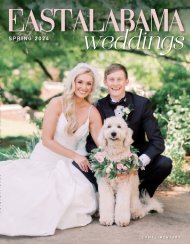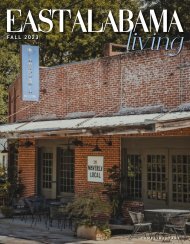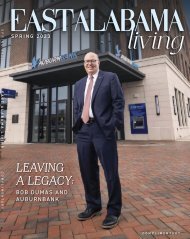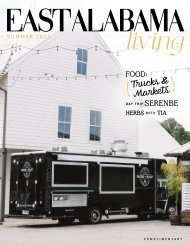East Alabama Living Spring 2022 Issue
Create successful ePaper yourself
Turn your PDF publications into a flip-book with our unique Google optimized e-Paper software.
After tours were canceled the past two
years because of Covid, this year’s event is
filled with activities. The Pilgrimage Art Walk
is scheduled for April 2 from 10 a.m. until 4
p.m., while a tablescapes display and an
antique show will be held Friday and Saturday,
April 1 and 2.
Afternoon tea will be served Friday and
Saturday afternoons at 3 p.m. at the neo-classical
revival Shorter Mansion. A Tablescape
Cocktail Party highlights Friday night at
Margaret Hall, St. James Episcopal Church. An
elegant Sunday brunch is not to be missed at
the Shorter mansion from 9 a.m. until 11 a.m.
In a setting where a slower and gentler
time seemingly has stood still, the homes
are furnished in family heirlooms as a nostalgic
reminder of the wealth and culture of
the period. Eight homes are open for daytime
tours all three days from 10 a.m. until 4 p.m.,
while five homes are on the candlelight tour
from 6 p.m. until 9 p.m.
Named after an Indian Village, the site
along the Chattahoochee River that is now
Eufaula was occupied by three Creek Indian
tribes of the Muscogee Nation. One of these
was “the Eufaulas,” which is believed to mean
“high bluff” in their language.
When early explorers from Georgia looked for
fertile cropland, they settled on the high bluffs
in 1823, naming the area after the Creek Village.
Following the Treaty of Cusseta, 1832, the
Creeks ceded their land rights in the area.
Barbour County was incorporated. Major
General William Irwin, who served with an
Alabama militia unit during the Creek War of
1836-37, was granted several thousand acres
of land nearby Henry County.
After becoming a senator, General Irwin
established the first steamboat wharf along
Eufaula’s high bluffs. In his honor, Eufaula
became “Irwinton.” In 1843, the town was
renamed “Eufaula” because mail was constantly
misdirected to Irwinton, Georgia.
Eufaula was spared during the Civil War.
At the end of the war, 4,000 Union troops
were headed for Eufaula. The townsfolk had
received news from river traffic that the war
had ended. Prominent citizens met Gen.
Benjamin Grierson under a flag of truce and
convinced him the war was over. To extend
southern hospitality, the mayor invited the
general and his staff to dinner.
The Eufaula Heritage Association was
formed in 1965 to prevent the loss and destruction
of the town’s historic treasures. The association
purchased Shorter Mansion at auction
and made it the headquarters for the association
and the annual Eufaula Pilgrimage. Photos
and artifacts from Eufaula’s past can be seen in
the museum at Shorter Mansion.
Shorter Mansion and Fendall Hall are open
year-round for tours. Built between 1856 and
1860, Fendall Hall is operated as a historic
house museum by the Alabama Historical
Commission. The antebellum Italianate home
is decorated with family and period furnishings.
Initially built in 1884, Shorter Mansion was once
the home of Governor John Gill Shorter. Both
houses are open to the public Monday through
Saturday from 10 a.m. until 4 p.m.
Eufaula has over 700 structures listed on
the National Register of Historic Places. While
visiting during the pilgrimage, there are many
activities and a tour of homes for an enjoyable
day trip reflecting back in time.
EAST ALABAMA LIVING
25












